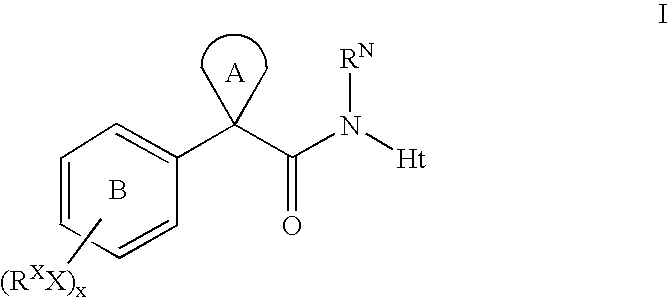Modulators of ATP-binding cassette transporters
a cassette and module technology, applied in the field of modulers of atp-binding cassette (“ abc”) transporters, can solve the problems of imbalance in ion and fluid transport, debilitating and fatal effects of cf, and reducing anion transport, so as to reduce the severity
- Summary
- Abstract
- Description
- Claims
- Application Information
AI Technical Summary
Benefits of technology
Problems solved by technology
Method used
Image
Examples
example 1
[0371]
[0372]2-Bromo-1-(chloro-phenyl)-ethanone Bromine (3.8 mL, 65 mmol) was added dropwise to a solution of 1-(2-chloro-phenyl)-ethanone (10 g, 65 mmol) in acetic acid (75 mL) at 0° C. The mixture was then warmed to room temperature and stirred overnight. The mixture was evaporated to dryness and used in the next step without further purification.
[0373]N′-[5-(2-Chloro-benzoyl)-thiazol-2-yl]-N,N-dimethyl-formamidine. A mixture of thiourea (4.95 g, 65.0 mmol) and dimethoxymethyl-dimethyl-amine (23.2 g, 195 mmol) in methanol (80 mL) was heated at reflux for 30 minutes. After allowing the mixture to cool, triethylamine (19.8 g, 195 mmol) and a solution of 2-bromo-1-(chloro-phenyl)-ethanone (crude from last step) in methanol (50 mL) were added. The mixture was heated at reflux for 4 hours. The solvent was removed and the residue was used directly in the next procedure.
[0374](2-Amino-thiazol-5-yl)-(2-chloro-phenyl)-methanone. The crude N′-[5-(2-7-chloro-benzoyl)-thiazol-2-yl]-N,N-dimethy...
example 2
[0386]
[0387]2-Chloro-3-(2-methoxy-phenyl)-propionaldehyde A solution of 2-methoxylaniline (24.6 g, 0.200 mol) in hydrochloric acid (20% aqueous solution, 80 mL) was slowly added to a solution of sodium nitrite (15 g, 0.22 mol) in water (40 mL) at 0 to 5° C. After stirring for 10 minutes, a cooled solution of acrolin (30 g, 0.56 mol) in acetone (200 mL) containing calcium oxide (4.0 g, 72 mmol) was added gradually, and then followed by a solution of cuprous chloride (2.0 g, 20 mmol) in acetone (20 mL) containing hydrochloric acid (20% aqueous solution, 4 mL). The mixture was stirred at 0 to 30° C. for 3 hours, and then extracted with three 150 mL portions of dichloromethane. The combined organic layers were washed with a saturated aqueous solution of sodium bicarbonate, a saturated aqueous solution of sodium chloride, dried over sodium sulfate, filtered, and concentrated to give a black viscous oil. The crude product was passed through a short silica column to give 10 g of crude prod...
example 3
[0392]
[0393]2-Bromo-3-phenylpropionaldehyde A solution of bromine (15.2 g, 95.1 mmol) in 30 mL of dichloromethane was added to a solution of 3-phenyl-propionaldehyde (13.4 g, 100 mmol) in dichloromethane (150 mL) at 0° C. over 20 minutes. The reaction mixture was allowed to stir for 2 hours and then a saturated aqueous solution of sodium bicarbonate (100 mL) was added to the mixture. The organic layer was separated and the aqueous layer was washed with dichloromethane (50 mL). The combined organic layers were washed with water, a saturated aqueous solution of sodium chloride, and then evaporated to dryness to give an orange oil (14.2 g), which was used directly in the next step.
[0394]5-Benzyl-oxazol-2-ylamine A mixture of 2-bromo-3-phenylpropionaldehyde (14.2 g, crude from above) and urea (7.2 g, 0.12 mol) were heated at reflux for 15 hours in 200 mL of ethanol. The solvent was evaporated to dryness and the residue was diluted with dichloromethane (250 mL) and then washed with sodiu...
PUM
| Property | Measurement | Unit |
|---|---|---|
| temperature | aaaaa | aaaaa |
| temperature | aaaaa | aaaaa |
| pH | aaaaa | aaaaa |
Abstract
Description
Claims
Application Information
 Login to View More
Login to View More - R&D
- Intellectual Property
- Life Sciences
- Materials
- Tech Scout
- Unparalleled Data Quality
- Higher Quality Content
- 60% Fewer Hallucinations
Browse by: Latest US Patents, China's latest patents, Technical Efficacy Thesaurus, Application Domain, Technology Topic, Popular Technical Reports.
© 2025 PatSnap. All rights reserved.Legal|Privacy policy|Modern Slavery Act Transparency Statement|Sitemap|About US| Contact US: help@patsnap.com



